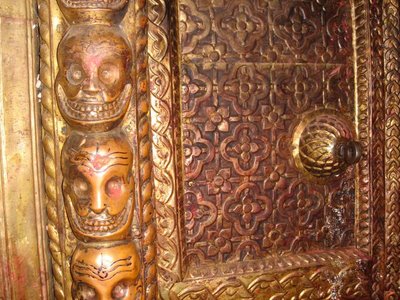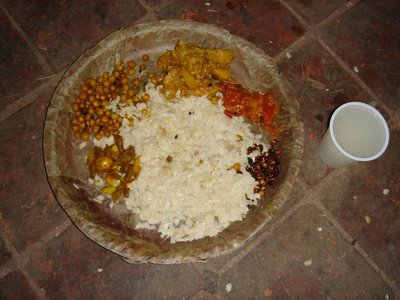Bhaktapur, Nepal
I am exhausted after managing to stumble into
 yet another one of my fairy-tale encounters with yet another fringe culture nearing extinction. After checking out the National Art Museum in Bhaktapur (some masterpieces of psychedelic tantric Buddhist and Hindu art are there), I had decided to track down the Nava Durga Dyochhen, supposedly home base for the Nava Durga dancers - ritual masked dancers who perform during the year for festivals in this most traditional of Nepali cities.
yet another one of my fairy-tale encounters with yet another fringe culture nearing extinction. After checking out the National Art Museum in Bhaktapur (some masterpieces of psychedelic tantric Buddhist and Hindu art are there), I had decided to track down the Nava Durga Dyochhen, supposedly home base for the Nava Durga dancers - ritual masked dancers who perform during the year for festivals in this most traditional of Nepali cities. Old ladies and uniformed schoolgirls pointed me down narrow, damp, mouldy alleys; I was sure they wanted me to get lost. After passing through what felt like very intimate private spaces - enclosed courtyards with ducks, chickens and laundry in tubs - I emerged onto Nava Durga Path (being able to read the street signs really comes in handy). The Dyocchen itself looks like a haunted house, Nepali style, with fearsome brass skulls and gables all over the place. The guidebook described it as "a mysterious tantric temple open only to initiates" (most Hindu temples here are "open only to Hindus," defined as being people who look Indian regardless of whether they are Buddhist, Christian or

 otherwise).
otherwise).I noticed that the usual spectacularly ornate carved doorway was missing something -the central figure directly over the door, goddess Durga, had been nicked. There's a book about this (The Gods Are Leaving the Country, all about Nepali art theft). Judging by the surrounding decorations, the centrepiece must have been masterful. It was sadly replaced by a hand-written paper sign in magic marker.
After being invited in by sweet, giggling Newari girls who spoke little English, I was told by the man who spoke the most English (very little as well) that the dancers were nowhere around and I could not talk to them. I stalled, though, and kept asking questions. In the back courtyard there were about 2 dozen people seated and someone addressing them through a loudspeaker.
It turned out THEY were the Nava Durga dancers themselves, and they were having a meeting! About what? About the fact that the dance company was having trouble, because all the young men (they are only male dancers) had to work jobs these days. They have not enough time for dance practice. And while they understood the need for money, the dance was having a hard time. The troupe elders felt that no one was really ready to dance. Festival season was around the corner, what to do?
Why on earth did the guy tell me the dancers were not around? and that it was "not possible" to speak to them? Did he just not understand my question?
It turned out that all the NavaDurga dancers belong to one Newari Hindu sub-caste, the flower sellers or Banamalas. Every single person there was surnamed Banamala. Bimesh Banamala, Gopal Banamala; the girl (any one of them could be models in the West; here they are a rupee a dozen) had the beautiful name ShivaKesari Banamala.
They were encouraged that an American woman was there wanting to learn about their dance, especially since the young people seemed to be losing some interest in it., and invited me to have dinner with them (traditional Newari food). Unfortunately, they spoke so little English all I could share was "yo khanna dehri mitoh cha" (Nepali for "this food is very tasty"), and so on.
Traditional Newari food was really good, and unusual, indeed. The mainstay is something call
 ed beaten paddy - flattened dried uncooked rice that is something like eating confetti. This, with soy beans, peas, big chunks of cooked ginger and roast garlic (my favourite), the ever-present Nepali potato, tomato relish and buffalo meat (which I skipped). This was topped off with Chang, a rice beer that looks just like watered-down milk and tastes just like watered-down beer. I noticed that I was the only lady present who was served Chang. It was so nice to have native food without fear of green chilis (always a problem in India).
ed beaten paddy - flattened dried uncooked rice that is something like eating confetti. This, with soy beans, peas, big chunks of cooked ginger and roast garlic (my favourite), the ever-present Nepali potato, tomato relish and buffalo meat (which I skipped). This was topped off with Chang, a rice beer that looks just like watered-down milk and tastes just like watered-down beer. I noticed that I was the only lady present who was served Chang. It was so nice to have native food without fear of green chilis (always a problem in India).We all sat on thick woven straw mats on the brick floor of the temple mandap (a sort of pavilion in the courtyard for gatherings) and the food was served on plates made of dried, pressed leaves. In south Asian fashion, 2 rows of people sit cross-legged opposite one another as volunteers move up and down the aisle in between with big vats of each item, ladling out more as you like. If you don't want more, you just block your leaf-plate with your hand and do the head-woggle thing (there are 2 or 3 head woggles and by now I know the one that means "no thanks" as opposed to the ones that mean "yes, " "i understand," and "I am pretending to say yes, but really will go on and do as I please."
The Newaris are a mysterious, quiet, creative, artistic and often beautiful people. Their origins are misty - they speak a language (considered one of the most difficult in the world) that is not Sanskritic based but Tibeto-Burman. It sounds like a cross between Nepali and Chinese, but is written in a Sanskritic script that looks like a fantastically ornate Hindi. "Jeen nakhateeni ghanay dhoona" means "I already had my dinner, thanks."
All the fantastical wooden carvings, stone masterpieces and brass doorways you see around the Kathmandu Valley - ALL of them - are products of the Newari culture. Newaris are both Hindu and Buddhist, with little division socially between them. Yet though they are responsible for most everything we associate with Nepali culture, they have never been the rulers of the valley, never the kings, and they comprise only a small percentage of the actual Nepali population. The entire valley is a profusion of teak gargoyles, serpentine nagas and snarling protector gods because of the tremendous creative energy of the ancient Newaris.
Anyway, I want to find out more about the Nava Durga dances - what they look like, when and where they are performed how you actually go about staging a performance, and what it means to the community involved. Every single members of the Banamalas have a role in the Nava Durga pageants. Bimesh, the "cool" modern Newari who spoke the most English, turned out to be not a dancer, but a sculptor who is working on the new crown for the temple's Durga statue. I am going to watch him work tomorrow at 10am. I had planned a nice day in the country at Changu Narayan temple, but life and ancient goddesses have a way of asserting themselves...especially in the Magic Kingdom.
I need a Nepali or Newari interpretor.














2 comments:
VIEWER MAIL
William in Birmingham, England writes:
you might like to know that your blog has actually inspired me to make my first trip to nepal...after travelling in south india for a number of years i decided to start my winter travels this year with a couple of months up there.
thanks for the accommodation advice...it's always good to have your first room sorted out when you arrive in a new place and well informed recommendations are great if you can get them.
Well COOL, always glad to help people act contrary to the official advice of the US State Department Traveller's Advisory (usually whatever they advice,
I do the opposite. They have a definite pattern of leaving when the fun is just getting started, for one thing.)
Post a Comment